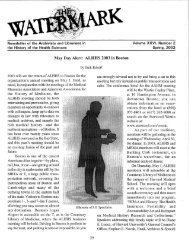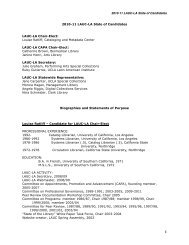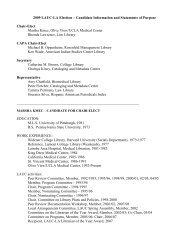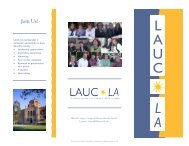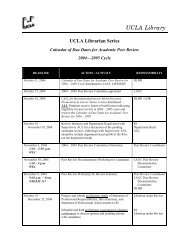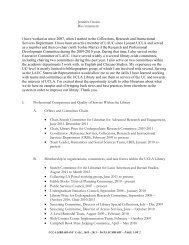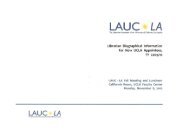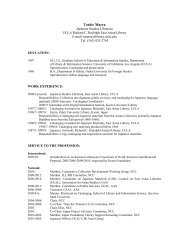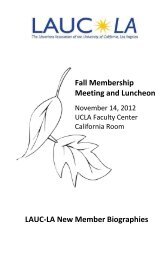Summer 2005 - UCLA
Summer 2005 - UCLA
Summer 2005 - UCLA
Create successful ePaper yourself
Turn your PDF publications into a flip-book with our unique Google optimized e-Paper software.
Watermark, Vol. XXVIII, No. 3 (<strong>Summer</strong> <strong>2005</strong>)<br />
an/Bisexual/Transgendered Awareness Month Lecture,<br />
“April and Renée: the Supermodel, the Tennis Player,<br />
and the Discourses of Trans/Sexual Difference.” In<br />
January 1970, a British court declared the marriage between<br />
male-to-female (MTF) transsexual supermodel<br />
April Ashley and aristocrat Arthur Corbett to be null<br />
and void. Seven years later, a New York court ordered<br />
that MTF athlete Renée Richards be permitted to play<br />
on the Women’s Tennis Association (WTA) circuit.<br />
O’Connor explored the differences between these two<br />
definitions of sex, asking what role medical expertise<br />
played in the courts’ decisions, and looking to the<br />
sharp divide between a British ruling of sex stasis and<br />
an American ruling of sex change.<br />
June 15: Ralph W. Moss, Ph.D., “Albert Szent-Györgyi<br />
and Cancer Alternatives.” The Hungarian-American<br />
scientist Albert Szent-Györgyi (1893-1986) was one of<br />
the leading biochemists of the twentieth century. He<br />
discovered vitamin C, for which he won the 1937<br />
Nobel Prize, and helped to unravel the citric acid cycle.<br />
But he is also remembered for his eventful life — fit, as<br />
he put it, for a spy novel. This basic scientist managed<br />
to become embroiled in controversies until the end of<br />
his life. Moss, the author of a biography of Szent-<br />
Györgyi and editor of The Moss Reports, a Web site<br />
and newsletter on alternative cancer therapies and<br />
referrals, worked with Szent-Györgyi for nearly seven<br />
years until the latter’s death in 1986.<br />
June 30: Peter Dans, M.D., “Hollywood and Women<br />
Doctors,” presented in conjunction with NLM’s current<br />
exhibit, “Changing the Face of Medicine: Celebrating<br />
America’s Women Physicians.” Dans, an internist with<br />
special interests in infectious diseases, geriatrics, quality<br />
assurance, and ethics, gave a kaleidoscopic tour of<br />
Hollywood’s portrayals of women doctors, using film<br />
clips from 1933’s Mary Stevens M.D. through 2002’s<br />
Blood Work. An independent consultant on issues related<br />
to geriatric polypharmacy and drug safety in the<br />
elderly, he is the author or co-author of more than 100<br />
scientific articles, book chapters, and other contributions<br />
to the medical literature. Since 1990, he has written<br />
movie reviews as “The Physician at the Movies”<br />
for Pharos, the quarterly publication of the Alpha<br />
Omega Alpha honor medical society. His book, Doctors<br />
in the Movies: Boil the Water and Just Say Aah!,<br />
about how doctors have been portrayed in movies from<br />
the 1930s through the 1990s, was published in 2000.<br />
Phil Teigen <br />
Book Reviews<br />
Bill Hayes. Five Quarts: A Personal and Natural<br />
History of Blood. New York: Ballantine Books, <strong>2005</strong>.<br />
290 pages, illustrated, 22 cm. $23.95 cloth, $14.95<br />
paperback. ISBN 0345456874 cloth, 0345456882<br />
paperback.<br />
Blood is what every human has in common, yet most<br />
of us are squeamish about the topic. Everyone knows a<br />
little bit of the blood story: how the veins carry blood<br />
to the heart and the aorta away from it; how blood turns<br />
red when it mixes with oxygen; how blood carries<br />
viruses and medicines. Hayes is a skilled storyteller. In<br />
Five Quarts he takes the reader through a journey of a<br />
different sort: from the scientific discoveries in pathology<br />
to the enormous amount of blood testing completed<br />
by today’s medical profession — all while he is coming<br />
to accept how his partner contracted the AIDS virus.<br />
This reviewer found herself easily absorbed by a subject<br />
that she did not expect to be so revealing. For<br />
Hayes, “blood also marks the divide between [him] and<br />
[his] partner of fourteen years” (p. 8). The author’s<br />
53




